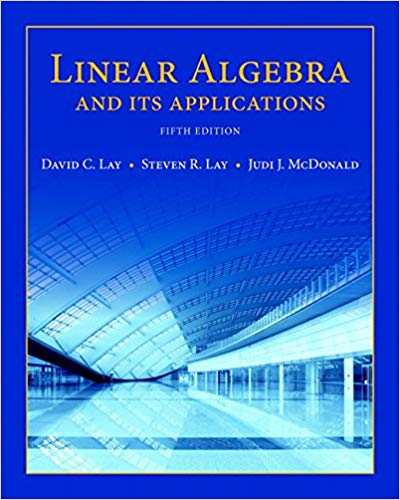
Linear Algebra and Its Applications, 5th Edition
Authors: David C. Lay, Steven R. Lay, Judi J. McDonald
ISBN-13: 978-0321982384
We have solutions for your book!
See our solution for Question 18E from Chapter 5.2 from Lay's Linear Algebra and Its Applications, 5th Edition.
Problem 18E
Chapter:
Problem:
It can be shown that the algebraic multiplicity of an eigenvalue λ is always greater than or equal to the dimension of the eigenspace corresponding to λ. Find h in the matrix A below such
Step-by-Step Solution
Given Information
We are given with a matrix A\[A = \left[ {\begin{array}{*{20}{c}}5&{ - 2}&6&{ - 1}\\0&3&h&0\\0&0&5&4\\0&0&0&1\end{array}} \right]\]We have to find h $h$ in the matrix A such that the eigenspace for $\lambda = 5$ is two dimensional.
Step-1: The matrix equation for eigenspace
\[\begin{array}{l}\left( {\left[ {\begin{array}{*{20}{c}}5&{ - 2}&6&{ - 1}\\0&3&h&0\\0&0&5&4\\0&0&0&1\end{array}} \right] - \left[ {\begin{array}{*{20}{c}}5&0&0&0\\0&5&0&0\\0&0&5&0\\0&0&0&5\end{array}} \right]} \right)\left[ {\begin{array}{*{20}{c}}{{x_1}}\\{{x_2}}\\{{x_3}}\\{{x_4}}\end{array}} \right] = \left[ {\begin{array}{*{20}{c}}0\\0\\0\\0\end{array}} \right]\\\left( {\left[ {\begin{array}{*{20}{c}}{5 - 5}&{ - 2}&6&{ - 1}\\0&{3 - 5}&h&0\\0&0&{5 - 5}&4\\0&0&0&{1 - 5}\end{array}} \right]} \right)\left[ {\begin{array}{*{20}{c}}{{x_1}}\\{{x_2}}\\{{x_3}}\\{{x_4}}\end{array}} \right] = \left[ {\begin{array}{*{20}{c}}0\\0\\0\\0\end{array}} \right]\\\left( {\left[ {\begin{array}{*{20}{c}}0&{ - 2}&6&{ - 1}\\0&{ - 2}&h&0\\0&0&0&4\\0&0&0&{ - 4}\end{array}} \right]} \right)\left[ {\begin{array}{*{20}{c}}{{x_1}}\\{{x_2}}\\{{x_3}}\\{{x_4}}\end{array}} \right] = \left[ {\begin{array}{*{20}{c}}0\\0\\0\\0\end{array}} \right]\end{array}\]
Step-2: The Augmented matrix Form
\[\begin{array}{l}M = \left[ {\begin{array}{*{20}{c}}0&{ - 2}&6&{ - 1}&0\\0&{ - 2}&h&0&0\\0&0&0&4&0\\0&0&0&{ - 4}&0\end{array}} \right]\\ = \left[ {\begin{array}{*{20}{c}}0&{ - 2}&6&{ - 1}&0\\0&{ - 2}&h&0&0\\0&0&0&4&0\\0&0&0&0&0\end{array}} \right]:;\,\,\left\{ {{R_4} = {R_4} + {R_3}} \right\}\\ = \left[ {\begin{array}{*{20}{c}}0&{ - 2}&6&{ - 1}&0\\0&{ - 2}&h&0&0\\0&0&0&1&0\\0&0&0&0&0\end{array}} \right]:;\,\,\left\{ {{R_3} = \dfrac{{{R_3}}}{4}} \right\}\\ = \left[ {\begin{array}{*{20}{c}}0&{ - 2}&6&{ - 1}&0\\0&0&{h - 6}&1&0\\0&0&0&1&0\\0&0&0&0&0\end{array}} \right]:;\,\,\left\{ {{R_2} = {R_2} - {R_1}} \right\}\\ = \left[ {\begin{array}{*{20}{c}}0&{ - 2}&6&0&0\\0&0&{h - 6}&0&0\\0&0&0&1&0\\0&0&0&0&0\end{array}} \right]:;\,\,\left\{ \begin{array}{l}{R_1} = {R_1} + {R_2}\\{R_2} = {R_2} - {R_3}\end{array} \right\}\end{array}\]
Step-3: The Augmented matrix Form
For two dimensional eigenspace, the system should have two fre variables. So, if $h=6$, then system will have two free variables
h=6
We are given with a matrix A\[A = \left[ {\begin{array}{*{20}{c}}5&{ - 2}&6&{ - 1}\\0&3&h&0\\0&0&5&4\\0&0&0&1\end{array}} \right]\]We have to find h $h$ in the matrix A such that the eigenspace for $\lambda = 5$ is two dimensional.
Step-1: The matrix equation for eigenspace
\[\begin{array}{l}\left( {\left[ {\begin{array}{*{20}{c}}5&{ - 2}&6&{ - 1}\\0&3&h&0\\0&0&5&4\\0&0&0&1\end{array}} \right] - \left[ {\begin{array}{*{20}{c}}5&0&0&0\\0&5&0&0\\0&0&5&0\\0&0&0&5\end{array}} \right]} \right)\left[ {\begin{array}{*{20}{c}}{{x_1}}\\{{x_2}}\\{{x_3}}\\{{x_4}}\end{array}} \right] = \left[ {\begin{array}{*{20}{c}}0\\0\\0\\0\end{array}} \right]\\\left( {\left[ {\begin{array}{*{20}{c}}{5 - 5}&{ - 2}&6&{ - 1}\\0&{3 - 5}&h&0\\0&0&{5 - 5}&4\\0&0&0&{1 - 5}\end{array}} \right]} \right)\left[ {\begin{array}{*{20}{c}}{{x_1}}\\{{x_2}}\\{{x_3}}\\{{x_4}}\end{array}} \right] = \left[ {\begin{array}{*{20}{c}}0\\0\\0\\0\end{array}} \right]\\\left( {\left[ {\begin{array}{*{20}{c}}0&{ - 2}&6&{ - 1}\\0&{ - 2}&h&0\\0&0&0&4\\0&0&0&{ - 4}\end{array}} \right]} \right)\left[ {\begin{array}{*{20}{c}}{{x_1}}\\{{x_2}}\\{{x_3}}\\{{x_4}}\end{array}} \right] = \left[ {\begin{array}{*{20}{c}}0\\0\\0\\0\end{array}} \right]\end{array}\]
Step-2: The Augmented matrix Form
\[\begin{array}{l}M = \left[ {\begin{array}{*{20}{c}}0&{ - 2}&6&{ - 1}&0\\0&{ - 2}&h&0&0\\0&0&0&4&0\\0&0&0&{ - 4}&0\end{array}} \right]\\ = \left[ {\begin{array}{*{20}{c}}0&{ - 2}&6&{ - 1}&0\\0&{ - 2}&h&0&0\\0&0&0&4&0\\0&0&0&0&0\end{array}} \right]:;\,\,\left\{ {{R_4} = {R_4} + {R_3}} \right\}\\ = \left[ {\begin{array}{*{20}{c}}0&{ - 2}&6&{ - 1}&0\\0&{ - 2}&h&0&0\\0&0&0&1&0\\0&0&0&0&0\end{array}} \right]:;\,\,\left\{ {{R_3} = \dfrac{{{R_3}}}{4}} \right\}\\ = \left[ {\begin{array}{*{20}{c}}0&{ - 2}&6&{ - 1}&0\\0&0&{h - 6}&1&0\\0&0&0&1&0\\0&0&0&0&0\end{array}} \right]:;\,\,\left\{ {{R_2} = {R_2} - {R_1}} \right\}\\ = \left[ {\begin{array}{*{20}{c}}0&{ - 2}&6&0&0\\0&0&{h - 6}&0&0\\0&0&0&1&0\\0&0&0&0&0\end{array}} \right]:;\,\,\left\{ \begin{array}{l}{R_1} = {R_1} + {R_2}\\{R_2} = {R_2} - {R_3}\end{array} \right\}\end{array}\]
Step-3: The Augmented matrix Form
For two dimensional eigenspace, the system should have two fre variables. So, if $h=6$, then system will have two free variables
h=6